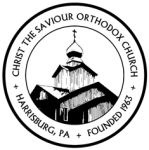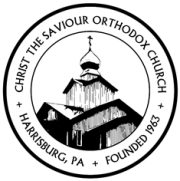Our Church Icons
These icons were "written" in the authentic and ancient Orthodox Christian tradition by Fr. Theodore Jurewicz, Master Iconographer. They were blessed by Metropolitan Theodosius and Archbishop Herman during the Divine Liturgy on October 18, 1998, as we celebrated our 35th anniversary.
If you would like to learn more about these icons, a booklet containing color photographs of all the icons, as well as a detailed explaination of each as written by John R. Barns, our parishioner and iconologist, can be purchased. Please e-mail us for more information.
"And behold, I am coming quickly, and My reward is with Me, to give every man according as his work shall be. I am Alpha and Omega, the Beginning and the End, the First and the Last." Revelations 22:12:13.
This powerful circular image of Christ depicts Him as The Pantocrator, or all sovereign, watching over His creation as ruler and judge.
This powerful circular image of Christ depicts Him as The Pantocrator, or all sovereign, watching over His creation as ruler and judge.
|
"...and there was darkness all over the earth..." St. Luke 23:44. Crucifixion was a cruel method of execution but one that the Lord willingly endured for mankind. Christ is shown dead in this icon to emphasize His humanity. The cross symbolizes the burdens we all must carry and has become the predominant symbol of Christianity.
|
|
The Dormition of the Theotokos is one of the twelve great feast days. Located on the west wall of our church, this icon represents the peaceful death of the Theotokos. We view this icon as we leave the church. It is a gentle reminder that we all pray for "A Christian ending to our life: painless, blameless, and peaceful".
|
The Wall of Saints consists of the following: St. Romanos, the Melodist; St. Jacob Netsvetov, Enlightener of the People of Alaska; Holy Hieromartyr Juvenal of Alaska and Holy Martyr Peter the Aleut; Holy Hierarch John, Archbishop of Shanghai and San Francisco; Holy Hierarch Tikhon of Moscow; Holy Priest Martyr John of Chicago; Holy Priest Martyr Alexander of New York City; Holy Blessed Xenia of St. Petersburg; Holy Hierarch Theophan the Recluse; Holy Righteous Alexis of Wilkes-Barre; Holy Priest Martyr Maksym of Carpatho-Rus; and Holy Hierarch Nicholas of South Canaan.
|

